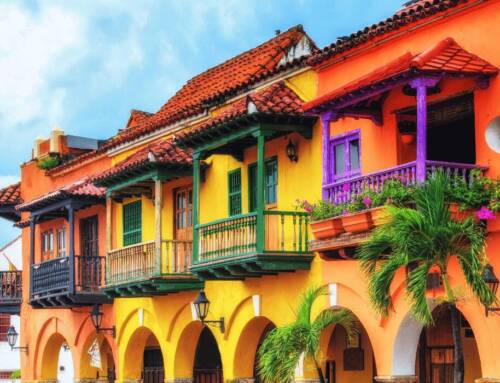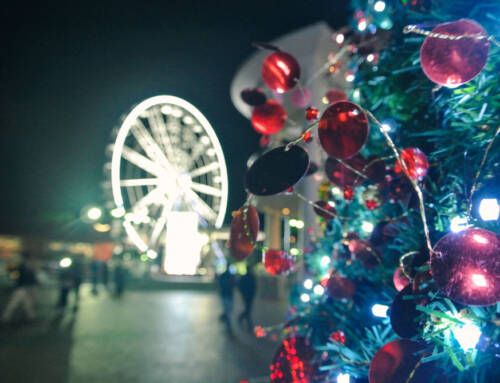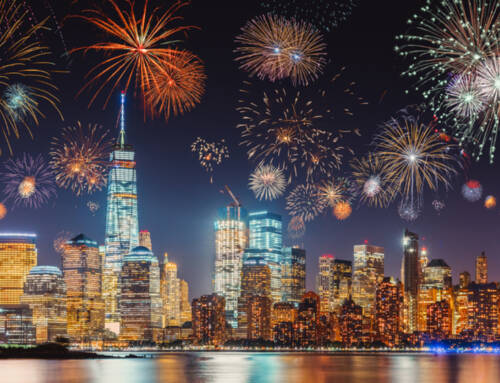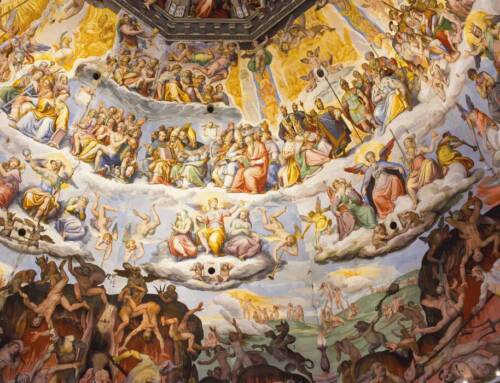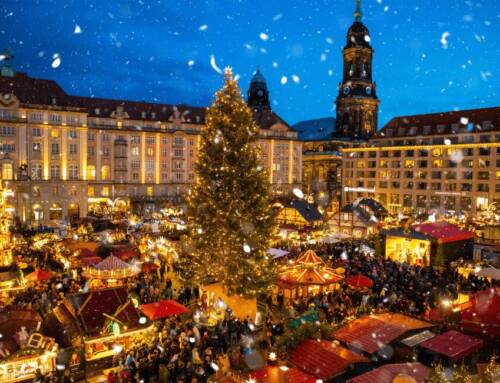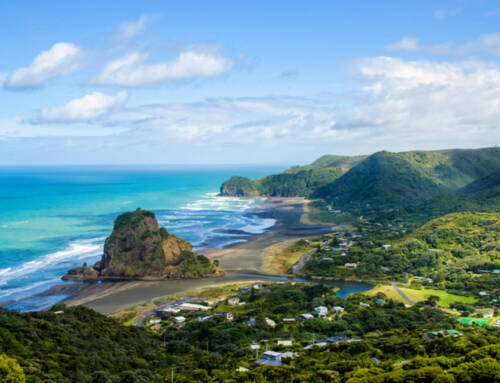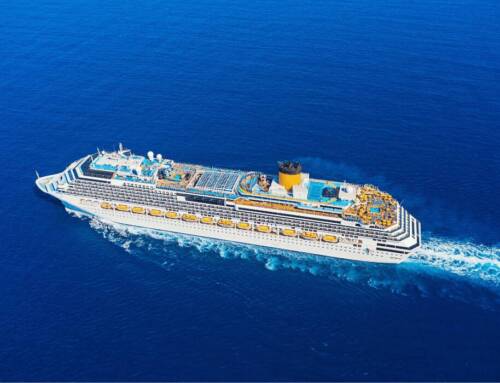When we think of sand dunes and towering skyscrapers, one of the first destinations that comes to mind is Dubai, the most popular of the seven emirates that make up the United Arab Emirates.
Dubai was originally a traditional pearl fishing village, but the discovery of oil in the 1960s completely transformed its economy. The result is the lavish city we know today, where just about anything you can imagine is possible.
Travelers visiting Dubai will find a vibrant mix of tradition and futurism, all set against the splendor of the desert. A collection of iconic skyscrapers, shopping malls, and massive beachfront resorts make up the perfect blend of innovation and culture.
Index
- Things to see and do in Dubai
- Burj Khalifa
- Dubai Fountain
- Dubai Frame
- Bur Dubai
- Al Fahidi Historical District
- Dubai Museum
- Deira District
- Dubai Miracle Garden
- Burj Al Arab
- Palm Jumeirah
- Atlantis Water Park
- Madinat Jumeirah
- Dubai Marina
- Jumeirah Mosque
- Kite Beach
- Dubai Mall
- Other Shopping Malls in Dubai
- Cruise on Dubai Creek
- Dubai Desert
- Visiting Abu Dhabi
- What is the most beautiful thing about Dubai?
- What should you not miss in Dubai?
- How many days do you need to see Dubai?
- What should you know before traveling to Dubai?
- Familiarize yourself with Dubai airport
- How much money do you need to visit Dubai?
- Travel safely to Dubai with Heymondo
And before you set off on your trip to Dubai, remember…
It is strongly recommended that all travelers purchase travel insurance with comprehensive medical coverage, as the healthcare system in the UAE is private and medical services can be extremely expensive.
Things to see and do in Dubai
Burj Khalifa
Dubai is known for its massive skyscrapers, the most famous of which is the Burj Khalifa. With its rocket-like silhouette and 828 meters in height, it holds the title of the tallest building in the world. This impressive architectural and engineering feat invites discovery through a variety of experiences.
For instance, the best panoramic views of the city skyline can be found from the observation deck on the 124th floor. You can also purchase tickets for “At The Top Sky” on the 148th floor, considered the highest outdoor observation deck in the world at 555 meters high.
As for tickets, access to floors 124 and 125 starts at around 40 euros, while tickets for the 148th floor range from 100 to 175 euros, depending on the time of day.
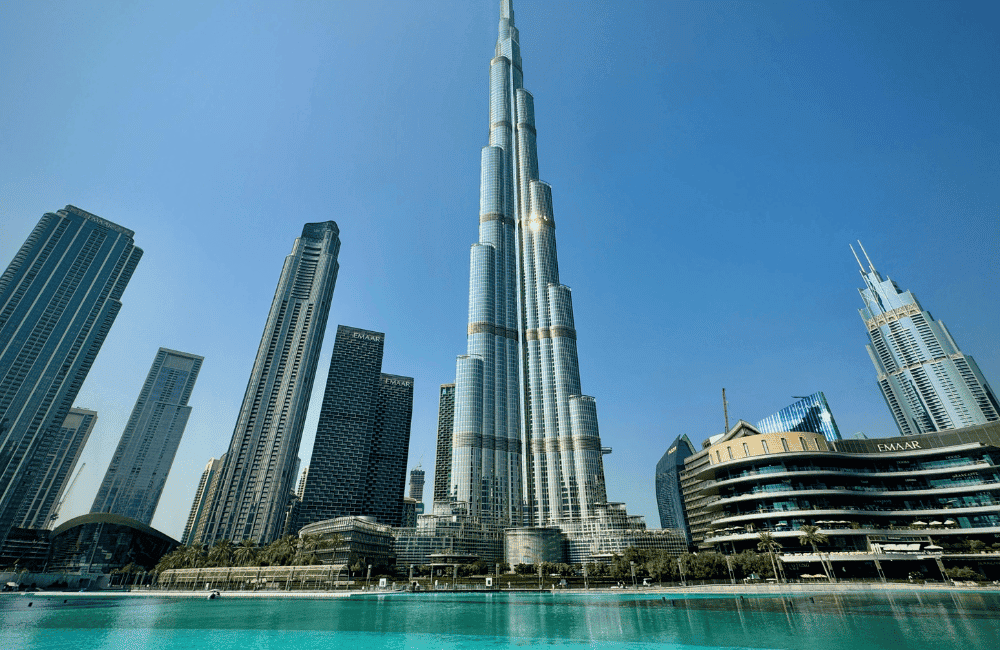
Dubai Fountain
After enjoying the views from the Burj Khalifa’s observation deck, there’s nothing better than heading down to witness the water, light, and music show at the famous Dubai Fountain, located at the base of the skyscraper. Inspired by the Bellagio Fountains in Las Vegas, this dazzling display takes place every 30 minutes between 6 p.m. and 10 p.m. You can choose the perspective you prefer, whether it’s from the Apple Store terrace or while dining at the Tribes restaurant—both must-visit spots located in the renowned Dubai Mall.
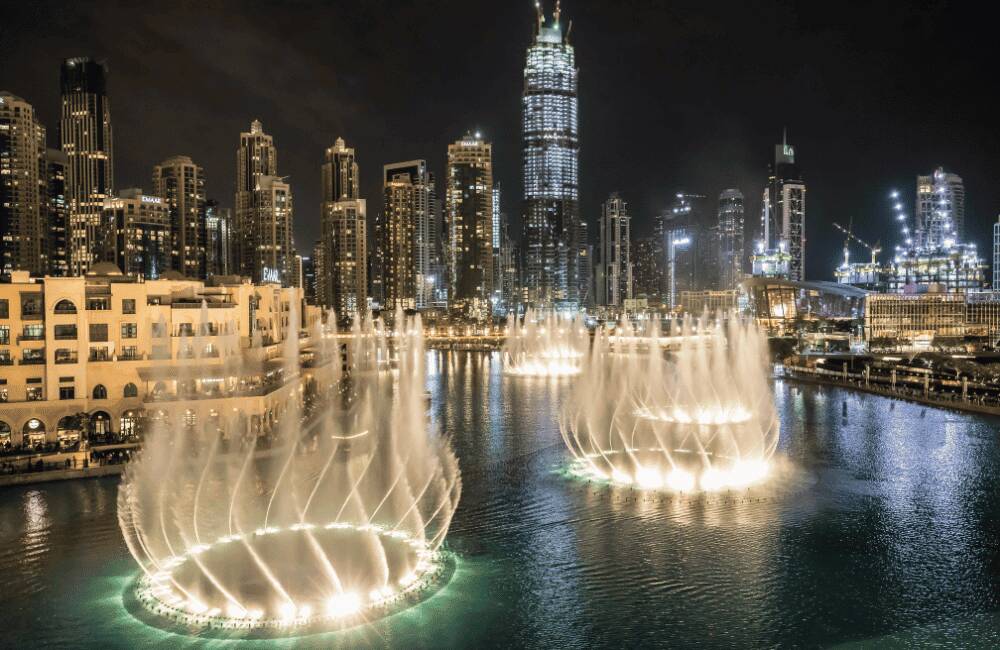
Dubai Frame
Dubai Frame is an iconic landmark shaped like a giant golden picture frame that offers visitors a unique perspective on the city’s past, present, and future. Standing 150 meters tall, it provides spectacular views of Dubai’s skyline. Equipped with a state-of-the-art elevator, visitors can reach the top and walk across the glass bridge that connects the two towers. This unforgettable experience also includes an immersive exhibition that showcases Dubai’s evolution from a small fishing village to the global hub it is today. Tickets to Dubai Frame cost 50 AED (around 12.40 euros).
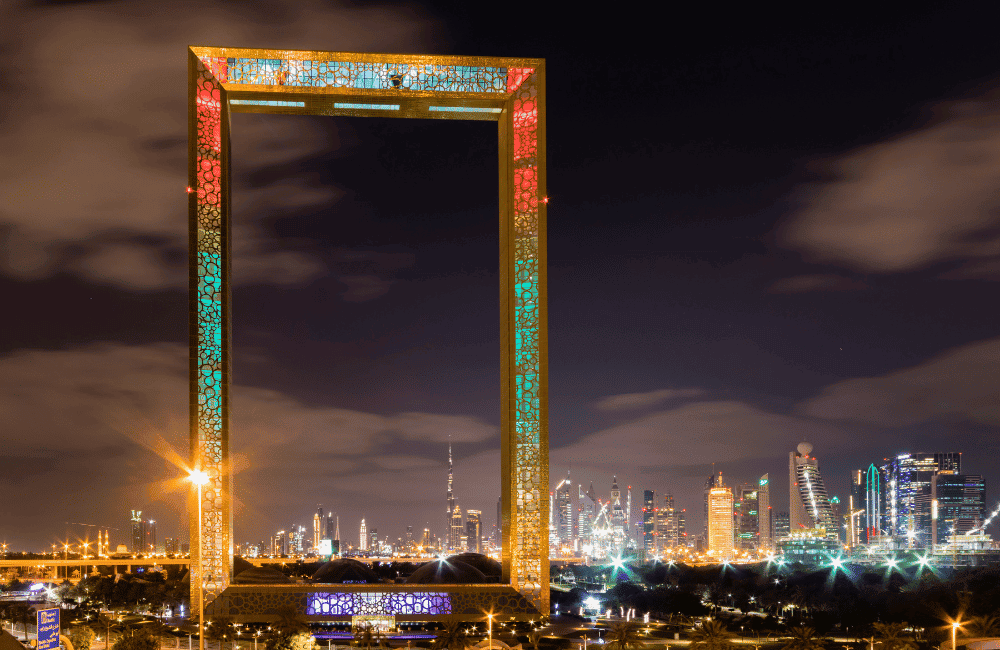
Bur Dubai
On the western bank of Dubai Creek—the natural inlet that runs into the city—you’ll find Bur Dubai, a district often considered the “mainland” of Dubai. This traditional area is perfect for wandering among grand mosques, visiting the country’s only Hindu temple, exploring museums and restored historic buildings, and discovering a few textile souks, although most of these are located in Deira or Al Fahidi.
Al Fahidi Historical District
Located on the eastern side of Dubai Creek in the Bur Dubai area, Al Fahidi is a restored heritage neighborhood offering a deep dive into traditional Middle Eastern architecture and culture. Entry is free and allows visitors to immerse themselves in buildings that evoke the traditional courtyard homes of the past. The narrow alleyways of Al Bastakiya, with their distinctive Arabic-style window eyes and wind towers, transport you back in time. It’s one of the most iconic places to visit in Dubai. The district is also home to Al Fahidi Fort, the oldest building in Dubai (dating back to 1787). In addition to traditional houses, the area also features cafés, art galleries, and several museums.
Dubai Museum
If you’re in Al Fahidi, don’t miss a visit to the Dubai Museum. It serves as a perfect kaleidoscope of various relics and antiques from Africa and the East, collected along trade routes that once made this part of the Persian Gulf a strategic port. Today, the museum focuses on a wide range of research related to Dubai’s archaeology and history.
Deira District
Along with neighborhoods like Al Fahidi, Deira makes up the area locals refer to as “Old Dubai.” It’s a journey back in time through a district perfect for getting lost among traditional alleyways that lead to the Gold Souk or the Spice Souk, packed with goods brought in by boats along Dubai Creek. This magical spot enchants with the sound of the adhan (Islamic call to prayer) echoing from local mosques, while restaurants like the iconic Bait Al Mandi tempt visitors with flavorful lamb and rice dishes.
Dubai Miracle Garden
Also known as the “Garden of the United Arab Emirates,” this marvel blends design and nature, featuring more than 100 million flowers across a space of 72,000 square meters. The largest natural flower garden in the world is famous for its unforgettable floral displays and constantly refreshed installations that offer new experiences each season. It’s a wonderland-worthy setting where castles intertwine with peacocks and storybook-style cottages. The garden is located next to the Dubai Butterfly Garden, home to over 15,000 butterflies.
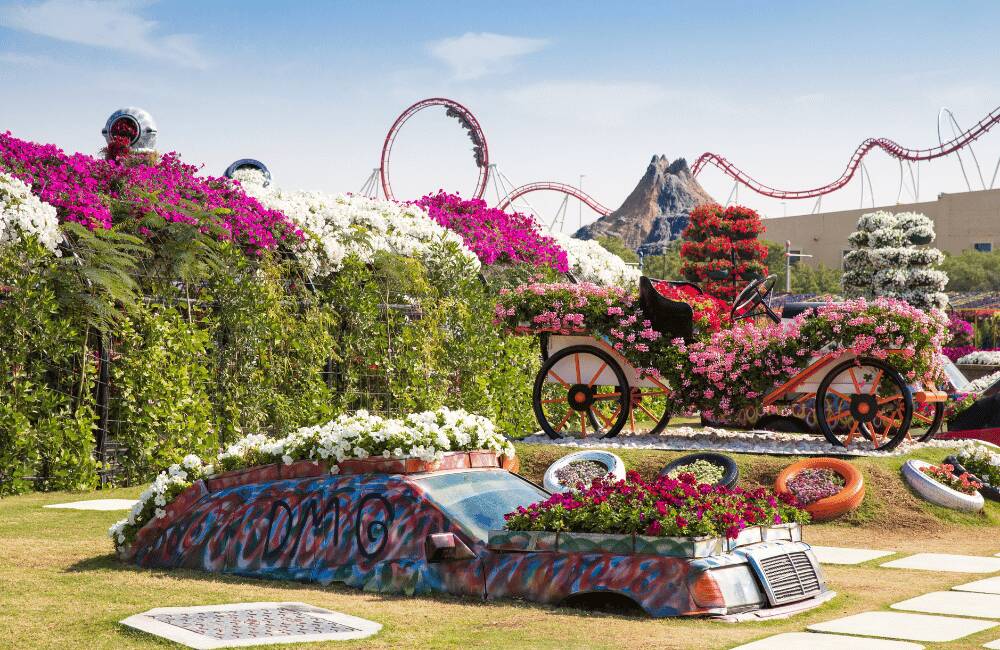
Burj Al Arab
Hotels are a vital part of Dubai’s futuristic ecosystem, thanks to iconic properties like the Burj Al Arab (or “Tower of the Arabs”). The world’s only 7-star hotel stands 321 meters tall and is designed to resemble the sail of a boat, floating on the artificial Palm Jumeirah island—an engineering marvel shaped like a palm tree. It’s an ultra-luxurious hotel where anything can happen—from butlers filling bathtubs with champagne to dining in an underwater restaurant. Even if you’re not staying at the hotel, you can still explore it through a 90-minute immersive tour or by reserving a table for tea or a drink at the Sky View Bar, which offers majestic views of the city skyline.
Palm Jumeirah
This artificial archipelago has become one of Dubai’s most iconic postcards since its opening in 2006. Palm Jumeirah resembles a palm tree from above and is divided into three parts: the trunk, the crown, and the crescent-shaped breakwater island. The palm’s “branches” house various private residences, while the rest includes some of the most popular attractions on Palm Jumeirah—ranging from panoramic views at the Palm Tower’s observatory, The View at the Palm, to the famous Atlantis Hotel.

Atlantis Water Park
Built right next to its namesake resort and accessible via the innovative Palm Monorail transport system, Atlantis Water Park deserves special mention. It is one of the largest water parks in the world, boasting over 105 slides, rides, and attractions. You can meet dolphins and sea lions at Atlas Village and live out the aquatic fantasies you dreamed of as a child.
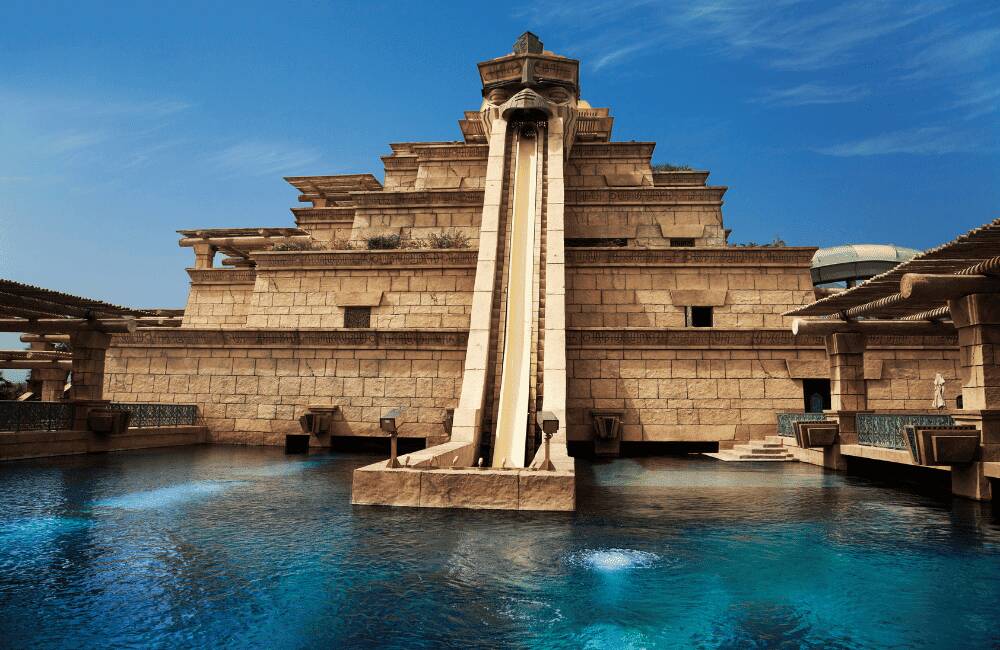
Madinat Jumeirah
If Dubai’s traditional neighborhoods leave you wanting more, Madinat Jumeirah in the Jumeirah area is a full-scale replica of an ancient Arabian citadel, complete with five-star hotels, dreamy souks, and beach clubs for the hedonists. Upscale restaurants like Pai Thai, a five-kilometer waterway that allows boat rides between old-style Dubai houses, and wellness havens like the Talise Spa, all contribute to a multiverse that embodies Dubai’s many contradictions.
Dubai Marina
Next to Palm Jumeirah lies another of Dubai’s “hot spots”—the Marina. Ranked by Time Out magazine as one of the “50 Coolest Neighborhoods in the World,” Dubai Marina has all the appeal you’re looking for in this emirate: awe-inspiring skyscrapers, beach days, and something for everyone. Ride the world’s longest urban zipline at XLine Dubai Marina or dine at Dinner in the Sky, where your meal is served 50 meters above the ground. Notable highlights include Dubai Harbour, with its massive cruise ship fleet, and Marina Walk, a scenic 7-kilometer pedestrian promenade that showcases daily life in the city.
Jumeirah Mosque
Located on its namesake avenue, the Jumeirah Mosque is the only mosque in the city that allows non-Muslim visitors. Built from white stone in the medieval Fatimid tradition, it features twin minarets flanking the central dome. Under the philosophy of “open doors, open minds,” the mosque offers 75-minute guided tours at 10 a.m., which share details about local holidays, ceremonies, and traditions related to Islamic construction. In addition to Jumeirah, there are other interesting mosques, such as Bastakiya Mosque. Though entry is not permitted, it’s still worth visiting from the outside to admire its architecture.
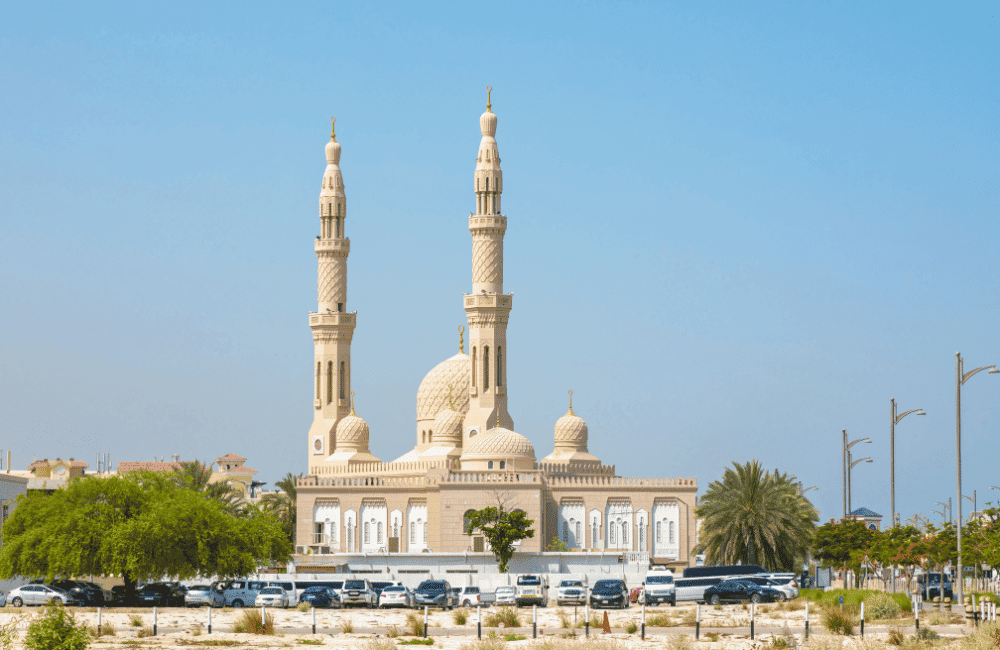
Kite Beach
Of course, Dubai features excellent beaches where you can soak in the sunset, enjoy a drink, or simply relax on the sand. Among the top beaches is Sunset Beach (also known as Umm Suqeim Beach), which—true to its name—is ideal for watching the sun go down, and perfect for photos with the Burj Al Arab in the background. Another great option is Kite Beach, Dubai’s only natural beach, known for its blue waters and colorful kites dancing in the wind.
Dubai Mall
The largest shopping mall in the world (1.1 million square meters) offers more than just a selection of over 1,200 stores ranging from Dior to Chanel, and Sony to Apple. It also features major attractions such as the Dubai Aquarium, one of the largest aquariums globally, with a 270-degree viewing tunnel and over 33,000 aquatic animals, including 300 sharks. You’ll also find fun experiences like Sony Park, with 27 rides inspired by movies like Cloudy with a Chance of Meatballs and Ghostbusters.
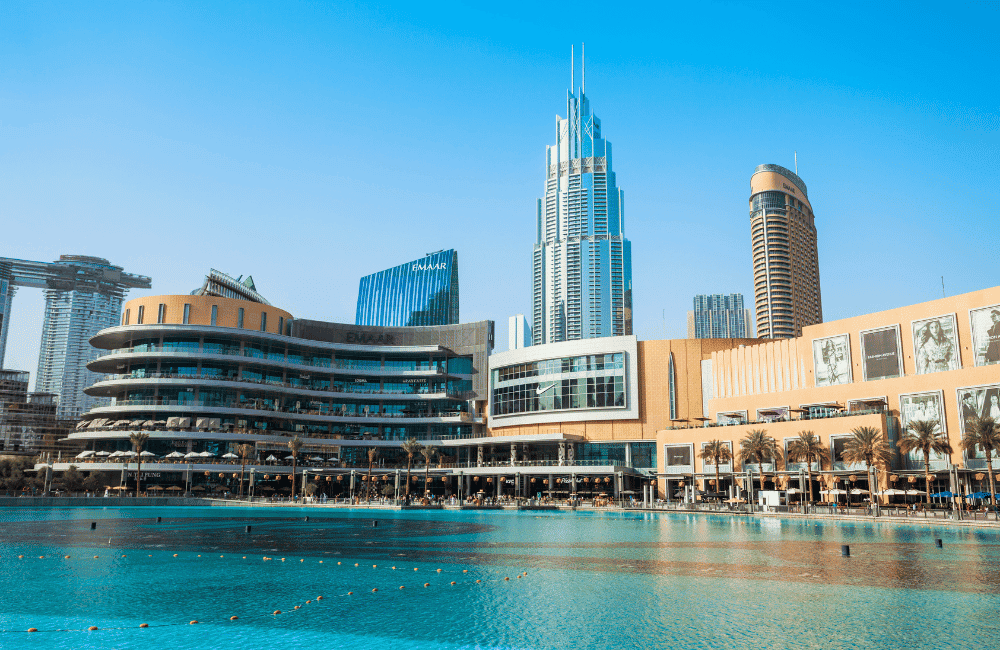
Other Shopping Malls in Dubai
If you’re looking for some of the biggest malls in the world, Dubai is the place. The city is a shopping paradise thanks to its enormous shopping centers that offer just about anything you can imagine. Beyond shopping, they provide a variety of experiences—from indoor ski slopes to themed areas that replicate countries around the world.
Some of the main malls in Dubai include:
- Mall of the Emirates, filled with luxury stores.
- Ibn Battuta Mall, where the decor transports you to places like India or Egypt.
- Souk Madinat Jumeirah, one of the top spots for finding traditional designs—perfect to end your shopping trip with a view of the Burj Al Arab.
Cruise on Dubai Creek
The famous 10-kilometer-long creek that flows through the city is a great place to enjoy a cruise on a traditional Arabic dhow sailing boat. Whether as a day excursion or a dinner cruise, it’s the perfect way to experience the city’s old-world charm and its stark contrast with Dubai’s modern and futuristic vibe.

Dubai Desert
The Arabian Desert is one of the most defining images of Dubai. A sweeping landscape of golden dunes, mountains that seem to touch the sky, and an air of mysticism surrounds every day-trip into the desert. Many tour operators offer a wide range of desert experiences, from meeting Bedouins and enjoying traditional meals to camel rides, sandboarding, and even nighttime safaris. Another option is renting a 4×4—either with a guide or on your own—and staying in one of the desert’s luxury hotels.
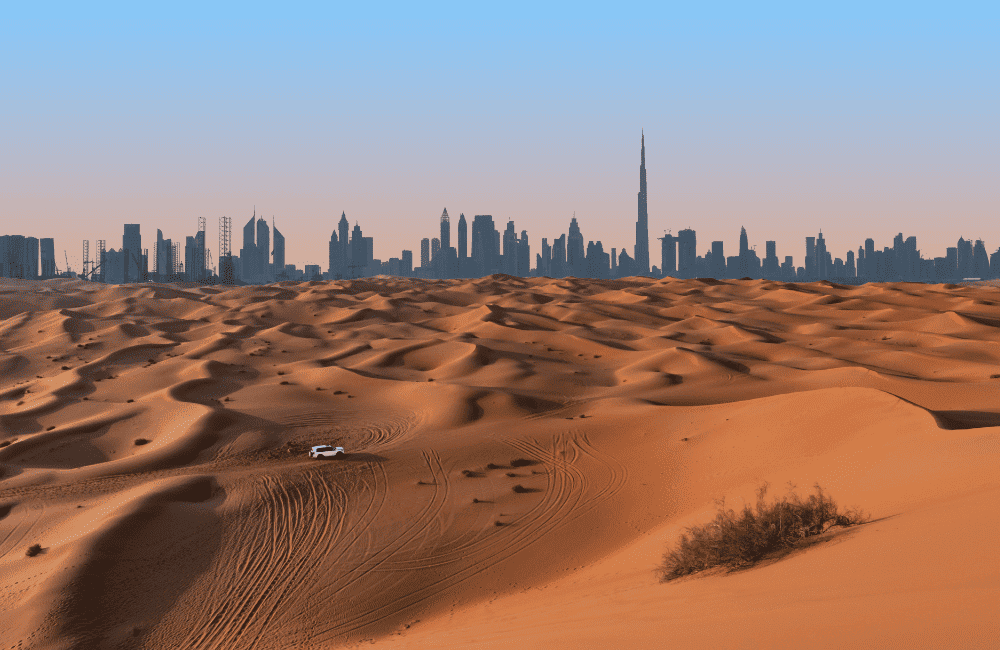
Visiting Abu Dhabi
If you’re spending several days in Dubai, setting aside a day to visit Abu Dhabi is a great idea. Located 140 km from Dubai, you can either take a flight or catch the E100 bus from Al Ghubaiba Station to reach the capital city. There, you’ll find some of the United Arab Emirates’ most impressive landmarks: the Sheikh Zayed Mosque, one of the largest and most stunning in the world; the opulent Emirates Palace hotel, considered the most expensive hotel on the planet; and Heritage Village, an open-air museum that walks you through the history of the Emirates.
What is the most beautiful thing about Dubai?
For many visitors, the most beautiful aspects of Dubai include the Burj Khalifa for its stunning architectural design, the old Deira district with its traditional charm, the desert, and the spectacular Dubai Fountain show.
Burj Khalifa
Dubai’s main appeal lies in its combination of tradition and modernity—especially when seen from above. For this reason, the Burj Khalifa is considered the most “beautiful” place in Dubai—not necessarily for the building itself, but because it offers the most special vantage point to appreciate everything that draws us to this city. From the observation decks on the 124th and 148th floors, you can take in this world of contrasts from an incredible location.
Deira and Al-Fahidi
If you’re looking for the kind of charm worthy of One Thousand and One Nights, the Deira and Al-Fahidi areas are among the most beautiful places to visit in Dubai. Winding alleyways offer views of Dubai Creek from various angles, leading to typical Arabic architecture paired with exquisite design, and colorful souks selling all kinds of goods. Add to that restaurants, shops, and art galleries that blend seamlessly into the surroundings.
Dubai Desert
After experiencing the city’s most beautiful modern and traditional sights, it’s time to embrace the country’s most stunning natural setting: the Dubai Desert. Whether you’re riding a camel or a 4×4 through the dunes and palm trees toward the ochre horizon, it offers one of the most picturesque scenes in all of Dubai.
Dubai Fountain
Dubai is a city that knows how to use various elements to create one-of-a-kind experiences. One of the most beautiful examples is the Dubai Fountain. This spectacular light and water show provides a shortcut to enchanting worlds and multiverses. Since the show happens daily and often, there’s no excuse not to experience this unforgettable moment.
What should you not miss in Dubai?
Among the must-see places in Dubai are the Burj Khalifa, the old district of Al-Fahidi, the desert, the massive Dubai Mall shopping center, and the Dubai Creek area.
Burj Khalifa
At 828 meters tall, the Burj Khalifa is Dubai’s most iconic symbol and an absolute must-see. If you’re only in the city for a short stopover, this skyscraper is essential—especially its two observation decks on the 124th and 148th floors, or the world’s highest restaurant-bar, At.mosphere, located on the 122nd floor.
Al-Fahidi
Dubai’s old quarter offers a unique contrast to the city’s modern skyline, inviting you on a journey through medieval alleyways, iconic forts, and scenes straight out of an Arabian tale. It’s a micro-universe where you can better understand Dubai’s development, enjoy delicious cuisine, and take a break from shopping in the futuristic malls that symbolize the city’s embrace of modernity.
Dubai Desert
The Dubai Desert is another can’t-miss attraction, offering breathtaking natural beauty. A desert excursion unveils both a spectacular landscape and a deeper look into the area’s ecosystem and early beginnings. Whether you opt for a short tour or a glamping stay among the dunes, the desert offers countless ways to uncover its secrets.
Dubai Mall
Located next to the Burj Khalifa, Dubai Mall proves that malls in Dubai are far more than places to shop. In fact, hundreds of unique worlds are housed within its extravagant walls. As the largest shopping center in the world, it illustrates how anything is possible in Dubai—from the most exclusive boutiques to amusement parks and one of the most impressive aquariums on the planet.
A stroll along Dubai Creek
Dubai’s “creek” is a signature location for understanding the city’s commercial history, observing contrasts, and enjoying scenic skyline views. Book a ride on a dhow, the traditional Arabic sailing boat, and save time while journeying through a one-of-a-kind route that connects you to other must-sees like the old Al-Fahidi district and the vibrant souks of Deira.
How many days do you need to see Dubai?
Like many destinations, Dubai caters to different types of trips. Generally, a 2- to 3-day getaway is enough to enjoy what the city has to offer—from visiting iconic sites to experiencing its beaches and restaurants.
However, you might want to extend your stay to 5 days if you’re interested in visiting water parks, taking longer desert excursions, or exploring less popular but equally worthwhile attractions. A longer stay also allows for day trips to nearby cities of interest like Abu Dhabi.
There’s also the option to explore Dubai in just 1 day—common during stopovers in the Emirati hub. In that case, while time is limited, you can still visit landmarks like the Burj Khalifa and Burj Al Arab, along with one of the city’s malls.
What should you know before traveling to Dubai?
Travel requirements for Dubai
The travel requirements for Dubai depend on your nationality. However, for Spanish tourists, all you need is a valid passport with at least six months remaining. A visa is not required for stays under 90 days. Lastly, it’s strongly recommended that you purchase top-tier international travel insurance to explore new destinations with complete peace of mind.
Is Dubai a safe Emirate?
Dubai is one of the six safest emirates in the United Arab Emirates. Penalties for committing crimes in Dubai are very severe, which helps maintain high levels of public safety. Still, as with any travel destination, it’s important to exercise common sense.
Visiting Dubai doesn’t have to be expensive
Many people associate Dubai with towering hotels, excessive tourism, and exclusive parties, assuming it’s a pricey destination. While it’s true that Dubai offers an endless array of experiences—some truly surreal—and budgets can stretch sky-high, it is possible to visit Dubai on a reasonable budget if you plan wisely.
If you’re traveling on a tighter budget, you can opt for more affordable hotels, dine at mid-range restaurants, or even grab fast food. Take advantage of discounts on transport passes and explore the many free attractions, like visiting the city’s traditional neighborhoods.
The best time to visit Dubai
Summer (May to September) brings the highest temperatures, which can reach up to 50°C (122°F), and it’s also the least crowded time for tourists. On the other hand, winter sees milder temperatures and more visitors—which also means higher prices.
The ideal time to visit is between October and April, when the weather is more pleasant. That said, Dubai doesn’t really have a “low season,” so any time of year can be a good time to go.
Where to stay in Dubai
Beyond choosing a hotel that suits your budget, it’s important to consider the area where you’ll be staying.
If it’s your first time visiting, Downtown Dubai is your best bet, since it’s home to key attractions like Dubai Mall, the Burj Khalifa, and the Dubai Fountain. Of course, areas like Palm Jumeirah tend to be more expensive—but you might be surprised by the range of options available in this futuristic capital.
How to dress in Dubai
Depending on the season, especially in summer, it’s recommended to wear natural fabrics like cotton or linen, along with loose-fitting clothing.
Keep in mind that while Dubai is more liberal than some neighboring emirates, dress codes still apply. For example, when visiting mosques, avoid wearing shorts, low-cut tops, sheer clothing, or anything too flashy—these are not appropriate in such settings.
In non-religious areas, it’s acceptable to wear knee-length dresses, sleeveless tops, and even leggings. As for swimwear, opt for modest pieces.
For men, it’s recommended to avoid wearing sneakers in more formal settings, as Dubai places a high value on elegance, and this type of footwear may not be accepted in certain restaurants or hotels.
Familiarize yourself with Dubai airport
Though it may seem like a minor detail, it’s worth researching Dubai Airport in advance—it’s one of the largest airports in the world. Avoid scheduling activities immediately after arrival, and choose your preferred mode of transportation, whether it’s taxis, the metro, or buses.
Taxis are convenient and affordable, and you’ll find plenty in the arrivals area. You can also book rides through apps like Careem or Uber.
The metro’s Red Line connects to Downtown in just 25 minutes from Terminals 1 and 3, making it the most budget-friendly option.
If you’re considering taking the bus, keep it as a last resort—it makes frequent stops and there’s currently no hop-on-hop-off tourist bus service. However, public buses can be used if you purchase a Nol Card in advance.
Lastly, if you want to save time navigating the terminals with luggage in tow, booking a private transfer in advance is one of the best options.
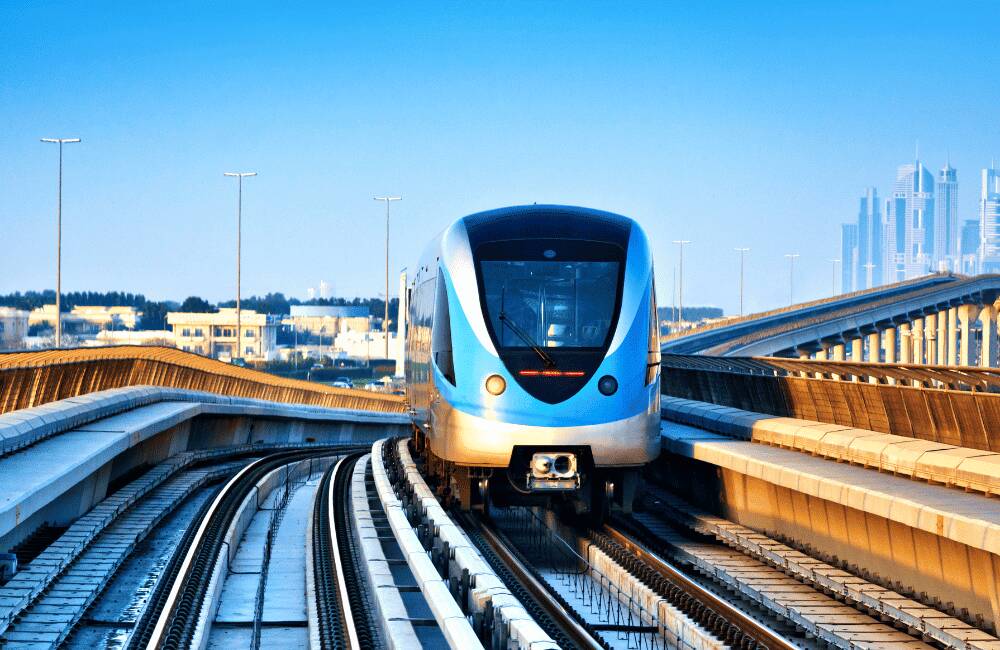
Dubai and alcohol
Though Dubai is more open than some of its neighbors, Islamic law still applies, and you’ll need to be aware of certain rules—especially regarding alcohol.
The legal drinking age is 21, and while you can order drinks in hotels and restaurants, it is illegal to drink or be intoxicated in public.
Under UAE law, this is considered a punishable offense, so it’s best to drink responsibly and save the partying for appropriate venues.
Be aware of Dubai’s holidays
During Islamic holidays like Eid or Ramadan, many of the city’s experiences may be limited. These celebrations can also affect public transportation, so it’s advisable to check the dates in advance.
During Ramadan, for example, food and drink may not be available before sunset in certain places.
Buy the Go Dubai Card
If you want to save money on various attractions in Dubai, here’s a tip: purchase the Go Dubai Card.
This pass offers up to 50% off admission at more than 49 attractions in Dubai and Abu Dhabi. You can choose from 3, 4, 5, or 7-day options, and it includes access to must-see spots like the 148th floor of the Burj Khalifa.
If you have a layover in Dubai
You might limit your trip to a stopover in Dubai, which is common for travelers going from Europe to Asia—especially since many airlines, like Emirates, include a free stop in the city!
In this case, to save time and energy, consider enrolling in the Dubai Connect program. This service is available to all passengers with layovers between 10 and 24 hours and includes hotel accommodation, transfers, meals, and discounts on tours.
Make sure to read the terms and conditions carefully, as you must meet specific requirements—such as a minimum fare spend on your Emirates flights.
Once qualified, you need to book Dubai Connect at least 24 hours before your flight. When you arrive at the airport, simply go to the Arrivals area and look for the Dubai Connect desk, where staff will assist you and answer any questions.
There are also tour packages specifically designed for travelers spending just a few hours in the city. You can even take a guided tour in Spanish to help you make the most of your limited time.
How much money do you need to visit Dubai?
If you’re wondering how much money you’ll need in Dubai, it really depends on how many days you plan to stay.
Although prices may drop slightly in the low season, Dubai’s offerings generally don’t fit into the “backpacker” or “budget trip” categories.
Restaurant prices in Dubai
In terms of dining, you can expect to spend between AED 36–60 (about €9–15) for fast food, AED 50–150 (around €12–35) at mid-range restaurants, or up to AED 2,000 (€400) for gourmet dinners.
A reasonable daily food budget would be around €40–50.
Hotel prices in Dubai
Dubai has begun opening up to more affordable accommodations like hostels (some starting at AED 120, or about €15), while mid-range hotels range from AED 120–160 (€30–40).
For example, a night in a 3-star hotel for two people typically ranges from AED 200–800 (€50–200), whereas luxury hotels start around AED 1,200 and can go up to AED 3,200 (€300–800 per night).
If you’re looking for even more opulence, a night at the 7-star Burj Al Arab can cost up to AED 4,000 (around €1,000) during low season.
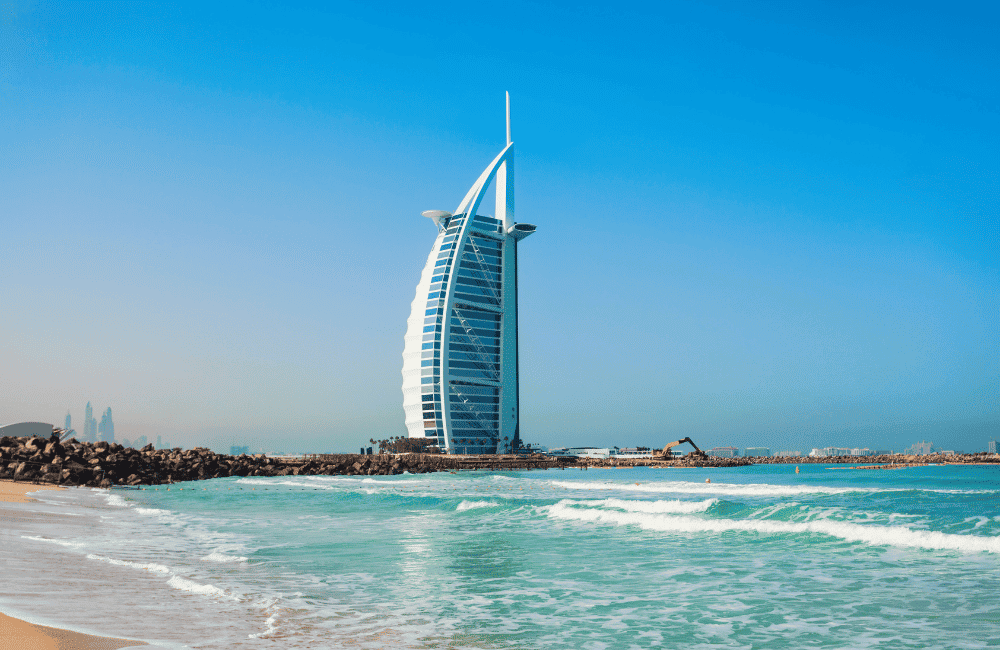
Transportation prices in Dubai
Transportation fares in Dubai range from AED 7 (€1.73) for a bus or metro ticket to AED 12 (€3) for short taxi rides, and up to AED 60 (€15) for longer trips—such as from the airport to the city center.
Travel cards like the Nol Card are ideal for budget-conscious travelers, with an initial top-up option starting at AED 19 (€4.71).
Tourist attraction prices
You should also factor in the cost of major attractions such as:
- Burj Khalifa: AED 224 (€55) during prime hours, AED 149 (€36) during off-peak times
- Dubai Miracle Garden: AED 95 (approx. €24)
- Aquaventure Waterpark: AED 315 (approx. €78)
Remember, with the Go Dubai Card, you can reduce entrance fees by up to 50% at over 49 attractions across Dubai and Abu Dhabi.
In this way, excluding flights, the daily cost per person in Dubai typically ranges from AED 350–400 (€85–100), including meals, lodging, transportation, and attractions.
What currency should you bring to Dubai?
When traveling to Dubai, it’s best to use the local currency: the UAE dirham (AED). The dirham is widely accepted at hotels, shopping malls, and major points of interest.
That said, many businesses in Dubai also accept U.S. dollars and euros. However, if you plan to rely exclusively on those currencies—especially at smaller hotels, local shops, or markets—it’s better to convert your money and use the local currency.
Travel safely to Dubai with Heymondo
Dubai offers an incredible range of experiences, so if you’re already planning your trip—don’t forget to pack Heymondo travel insurance!
Traveling with insurance is essential, as medical care in the UAE can be extremely expensive.
Our international travel insurance covers up to €10 million in medical expenses for illness or accidents, and you won’t have to pay upfront.
Ready to discover Dubai with the peace of mind Heymondo provides?
Featured stories

